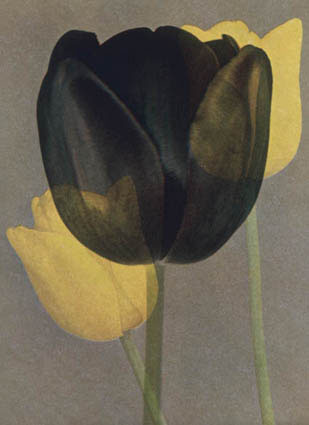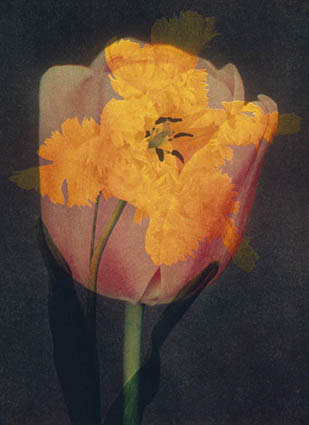Exhibitions
Archive

Bullish on Bulbs,
American Option,
Lambdaprint, acrylic, aluminium,
63 x 47 in, 2007,
Edition: 3
Lambdaprint, acrylic, aluminium,
63 x 47 in, 2007,
Edition: 3

Bullish on Bulbs,
Asian Option,
Lambdaprint, acrylic, aluminium,
63 x 47 in, 2007,
Edition: 3
Asian Option,
Lambdaprint, acrylic, aluminium,
63 x 47 in, 2007,
Edition: 3

Bullish on Bulbs,
European Option,
Lambdaprint, acrylic, aluminium,
63 x 47 in, 2007,
Edition: 3
European Option,
Lambdaprint, acrylic, aluminium,
63 x 47 in, 2007,
Edition: 3
Rémy Markowitsch
Bullish on Bulbs - A Game of Chance
Bullish on Bulbs - A Game of Chance
Galerie EIGEN + ART Berlin
27.10.2007 - 27.12.2007
27.10.2007 - 27.12.2007
Money is not only an existential necessity, it is also a real thrill to have money and make it grow. And there are few things that set the pulse racing faster than dealing on the stock exchange, particularly in options that can generate enormous profits or losses. So many innate human traits combine and play into this -- an instinct for hunting, a love of gambling, a passion for collecting, the byways of desire and the devil-may-care streak that is in all of us. It is a game of chance that can become highly addictive. In the exhibition Bullish on Bulbs at the Galerie EIGEN + ART in Berlin, Rémy Markowitsch explores these traits, which form the motor that drives capitalism. As in all his projects, he combines a huge diversity of references to create an imaginary chamber of associations, and the door to this chamber is opened by the sensuality and seductiveness of these objects and pictures. Rémy Markowitsch's works take their cue from his engagement with literature and research, travel and discoveries, the appropriation of things alien, colonialism, a passion for collecting and the nature of addiction. At the same time they reflect on his chosen media of photography, books, video and language. Light - transluminating, illuminating, elucidating, enlightening - plays a central part in his work. For the series Nach der Natur/After Nature (1991-98) and On Travel (2004), for instance, Markowitsch made expeditions into the pictorial worlds he found in books. In the metaphorical and the literal sense, he sheds light on and through these photographic interpretations of the world, photographing motifs on two sides of the same page so that they are superimposed. All his photographic works are guided by the same principle. When it came to Bibliotherapy (2001-03) with the huge, glowing sculpture Bonsai Potato at its centre, Rémy Markowitsch was engaging with the book as a repository of knowledge, feelings and experiences. While Bibliotherapy and On Travel variously explore the archetypal human desire to accumulate knowledge and reflect on reading and looking at pictures as imaginary journeys, passions and addictions, You are not alone, vol. 1 (2004) additionally examines states of consciousness and human perception under the influence of alcohol, an entirely legal drug. In Bullish on Bulbs (2007), Markowitsch uses bulbs or onions (the German word Zwiebel means both) as an analogy for the business of options trading, a game about the promise of raking it in. For all its simplicity, the onion not only features in almost all daily meals, in places such as India, the cost of onions can affect even the most elevated political circles. No government can afford social unrest due to rising food prices. But onions are not just a potential source of nutrition, in the plant world - as tulip or lily bulbs - they also have the option of becoming flowers - a wonderful metaphor. What's more, the first stock exchange crash in history, in 1637, was brought on by the collapse of the tulip trade in Holland. The tulip bulbs that came to Europe from China via the Ottoman Empire and the onions that we eat - as reified potential and as a commodity - are used by Markowitsch as symbols of the way that human beings treat things and values. At the same time they also provide enough comedy to keep pathos at bay. In the exhibition Bullish on Bulbs, a polyester object some three meters in height is suspended from the ceiling. It is an onion, illuminated from within, which - gigantically enlarged - has been transformed into a sensual, strangely appealing object. In stock-market circles the term "bullish" refers to an anticipated rise in prices, an increase in profits: in short, good luck. In the eponymous tulip series Bullish on Bulbs, Rémy Markowitsch relates today's trade in tulip bulbs to the 17th-century when speculation ran amok, with people paying the price of a house for one single tulip bulb. His studies in the ambivalence of beauty and sexiness as marketing ploys incorporate implications of the current stock markets, as illustrated in such titles as the American, Asian or European Option.The video Bubbles and Tears shows a gushing shower head wrapped in a ‘turban' (echoes of the Ottomans, who once satisfied the European mania for tulip bulbs) while people can be heard weeping on a soundtrack of audio clips from American, Asian and European films. It makes one shudder and laugh in the same breath: the capitalist system is indeed ambivalent; it is an unholy concatenation of money, sex and power. Buyer and seller, good luck and bad luck need each other. In the last room, Markowitsch applies the workings of money, desire and greed that underlie Bullish on Bulbs to another semantic context within the complex ramifications that link market, money and politics. The International Jew (2007) is a transluminated portrait juxtaposing automobile tycoon Henry Ford with an aerial view of an oil field and drilling rigs belonging to the Standard Oil Company founded by John D. Rockefeller. In this work, the artist highlights the inescapable tangle of the money market, anti-Semitism, politics, industry and war -- weighty words that address complex political and historical issues. Markowitsch has succeeded in inventing an imagery for them that lies lightly suspended in the air though it is a heavy, darkening thundercloud.It was after seeing hogs being dismembered in Chicago's stockyards that Henry Ford came up with the idea of reversing the process. Mass production of cars through assembly-line technology, progressive working conditions and relatively good pay (so that even workers could afford to buy a car!) were the fundamental principles of what came to be known as Fordism. However, there is little in that concept that would betray Henry Ford's pronounced anti-Semitism. In his book The International Jew. The World's Foremost Problem, published in 1920, Ford propagates anti-Semitic clichés -- for instance the theory of a global Jewish conspiracy -- with cool hatefulness that whips up the fear of supposedly dangerous and powerful Jewish bankers. For Adolph Hitler, the pamphlet, already available in German translation by 1922, obviously pushed at an open door. In 1938 Ford was awarded the Grand Cross of the German Eagle, the highest medal that could be bestowed on a foreigner, and the Ford Motor Company plant in Berlin produced cars and tracked vehicles for the German Wehrmacht. In this respect, Ford contributed substantially to Nazi preparations for the war, while also, it seems, receiving reparations after the war for the bombing of his German factories -- so much for the embroiled economics of war. Markowitsch's The International Jew transmutes the madcap irony of the subject matter into a visual cloud that is quite literally lightweight. It bears the entire weight of the disasters that can be conjured by capitalism, industrialization, the arms industry, the advantages of winning a war, anti-Semitism and racism. Similarly, the art market not only wants to acquire beautiful insights and intellectual delights but also added value, in other words, an increase in economic power. In Bullish on Bulbs, Markowitsch addresses both the vulgarity and convoluted ramifications of his subject matter with analytic irony. He focuses on the driving forces that turn the global gears of the economy, exposing economic, political and historical connections without being explicitly political. Above all, Bullish on Bulbs is an analysis that gives us a sensual experience of the psychological mechanisms that underlie trade across the board. Rémy Markowitsch has produced a visual essay on the optional thinking that is also the motor of life.
Nadine Olonetzky, September 2007 Translation: Catherine Schelbert